Mammalian LIN-7 PDZ proteins associate with beta-catenin at the cell-cell junctions of epithelia and neurons
- PMID: 10921879
- PMCID: PMC306606
- DOI: 10.1093/emboj/19.15.3978
Mammalian LIN-7 PDZ proteins associate with beta-catenin at the cell-cell junctions of epithelia and neurons
Abstract
The heterotrimeric PDZ complex containing LIN-2, LIN-7 and LIN-10 is known to be involved in the organization of epithelial and neuronal junctions in Caenorhabditis elegans and mammals. We report here that mammalian LIN-7 PDZ proteins form a complex with cadherin and beta-catenin in epithelia and neurons. The association of LIN-7 with cadherin and beta-catenin is Ca(2+) dependent and is mediated by the direct binding of LIN-7 to the C-terminal PDZ target sequence of beta-catenin, as demonstrated by means of co-immunoprecipitation experiments and in vitro binding assays with the recombinant glutathione S-transferase:LIN-7A. The presence of beta-catenin at the junction is required in order to relocate LIN-7 from the cytosol to cadherin-mediated adhesions, thus indicating that LIN-7 junctional recruitment is beta-catenin dependent and that one functional role of the binding is to localize LIN-7. Moreover, when LIN-7 is present at the beta-catenin-containing junctions, it determines the accumulation of binding partners, thus suggesting the mechanism by which beta-catenin mediates the organization of the junctional domain.
Figures
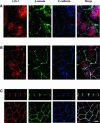

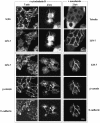
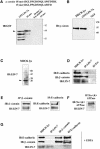
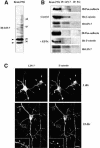
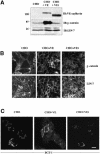
Similar articles
-
The cell junction protein VAB-9 regulates adhesion and epidermal morphology in C. elegans.Nat Cell Biol. 2003 Jul;5(7):619-25. doi: 10.1038/ncb1002. Nat Cell Biol. 2003. PMID: 12819787
-
Study on the formation of specialized inter-Sertoli cell junctions in vitro.J Cell Physiol. 1999 Nov;181(2):258-72. doi: 10.1002/(SICI)1097-4652(199911)181:2<258::AID-JCP8>3.0.CO;2-Q. J Cell Physiol. 1999. PMID: 10497305
-
Junctional recruitment of mammalian Scribble relies on E-cadherin engagement.Oncogene. 2005 Jun 23;24(27):4330-9. doi: 10.1038/sj.onc.1208632. Oncogene. 2005. PMID: 15806148
-
Physical and functional association of migfilin with cell-cell adhesions.J Cell Sci. 2005 Feb 15;118(Pt 4):697-710. doi: 10.1242/jcs.01638. Epub 2005 Jan 25. J Cell Sci. 2005. PMID: 15671069
-
Turn-off, drop-out: functional state switching of cadherins.Dev Dyn. 2002 May;224(1):18-29. doi: 10.1002/dvdy.10087. Dev Dyn. 2002. PMID: 11984870 Review.
Cited by
-
Cadherin-mediated intercellular adhesion and signaling cascades involving small GTPases.Cold Spring Harb Perspect Biol. 2009 Sep;1(3):a003020. doi: 10.1101/cshperspect.a003020. Cold Spring Harb Perspect Biol. 2009. PMID: 20066109 Free PMC article. Review.
-
Role of beta-catenin in synaptic vesicle localization and presynaptic assembly.Neuron. 2003 Nov 13;40(4):719-31. doi: 10.1016/s0896-6273(03)00718-9. Neuron. 2003. PMID: 14622577 Free PMC article.
-
Interactions between β-catenin and the HSlo potassium channel regulates HSlo surface expression.PLoS One. 2011;6(12):e28264. doi: 10.1371/journal.pone.0028264. Epub 2011 Dec 14. PLoS One. 2011. PMID: 22194818 Free PMC article.
-
Cytoplasmic interactions of syndecan-4 orchestrate adhesion receptor and growth factor receptor signalling.Biochem J. 2002 Nov 15;368(Pt 1):1-15. doi: 10.1042/BJ20021228. Biochem J. 2002. PMID: 12241528 Free PMC article. Review.
-
Recent Progress on Genetically Modified Animal Models for Membrane Skeletal Proteins: The 4.1 and MPP Families.Genes (Basel). 2023 Oct 15;14(10):1942. doi: 10.3390/genes14101942. Genes (Basel). 2023. PMID: 37895291 Free PMC article. Review.
References
-
- Borg J.P., Straight,S.W., Kaech,S.M., de Taddeo-Borg,M., Kroon,D.E., Karnak,D., Turner,R.S., Kim,S.K. and Margolis,B. (1998) Identification of an evolutionarily conserved heterotrimeric protein complex involved in protein targeting. J. Biol. Chem., 273, 31633–31636. - PubMed
-
- Butz S., Okamoto,M. and Sudhof,T.C. (1998) A tripartite protein complex with the potential to couple synaptic vesicle exocytosis to cell adhesion in brain. Cell, 94, 773–782. - PubMed
MeSH terms
Substances
LinkOut - more resources
Full Text Sources
Molecular Biology Databases
Miscellaneous

